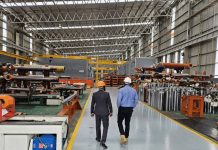Blasting is a key component of mining. Boiled down to its most essential elements, it involves drilling holes, placing explosives inside those holes, detonating the explosives, and clearing away the matter that’s been displaced. These steps are then repeated until the desired extent of excavation is achieved.
The use of explosives in mining dates back centuries, when gunpowder was first used in Hungary in 1627, so you’d be forgiven for assuming that blasting is a process that’s set in stone. In actual fact, it’s advancing very rapidly, as you’ll discover below.
- Zambia has broken world records for blasting
In September 2017, Johannesburg-headquartered explosives manufacturer and supplier BME broke the world record for the largest number of electronic detonators fired in a single blast. The ground-breaking feat was achieved right here, at Kansanshi Mine’s main pit. It was the same location where BME had previously set an in-house blasting record in March 2015.
The company’s 2015 record involved successfully detonating 4,141 Electronic Delay Detonators (EDDs) in a single blast. But BME blew that accomplishment away just over two years later during its record-breaking 2017 blast, when it successfully detonated 6,690 EDDs at Kansanshi. Approximately 400 tonnes of emulsion explosives were detonated!
- Reactive ground can cause spontaneous explosions
Sometimes, when certain sulphide minerals in the ground (usually iron or copper) come into contact with ammonium nitrate-based explosives, a chemical reaction occurs in which energy is released in the form of heat or light. The runaway reaction between the sulphides and the ammonium nitrate can lead to the spontaneous and unplanned detonation of explosives.
“Reactive ground” is the term used in the mining industry to describe this potentially dangerous phenomenon, and, as you can imagine, it’s something that can cause seismic headaches for blasting companies.
To overcome the problem of reactive ground, blasting companies need to test the area before putting explosives into the holes they’ve drilled. This usually involves a visual inspection of the site to check for tell-tale white patches around drill holes, followed by laboratory testing of the ground to confirm or refute any suspicions of reactive ground. In cases where reactive ground is identified, blasting companies will opt to use specially developed emulsion explosives that do not react under such conditions.
“Reactive ground” is the term used in the mining industry to describe this potentially dangerous phenomenon, and it can cause seismic headaches for blasting companies.
- Some explosives are made using a popular hair lightener
Blasting doesn’t only create a lot of dust and debris; it also generates a variety of gases. Most of these blast fumes are predominantly composed of nitrogen dioxide. That’s the chemical that creates orangey-red plumes of gas, with their distinctive, somewhat unpleasant smell. Even though blast fumes usually disperse quickly and do not pose an acute health risk, blasting companies have been working hard to develop explosives that produce significantly less nitrogen dioxide and other gases.
One such development is the so-called Blonde Bomb, a hydrogen peroxide-based explosive that is much safer and more environmentally friendly than traditional ammonium nitrate-based explosives. In fact, controlled detonation monitoring tests showed that post-blast fumes from hydrogen peroxide-based explosives contained zero nitrogen dioxide and much less carbon monoxide than ammonium nitrate-based explosives. The Blonde Bomb still packs a punch. Tests in Finland using hard volcanic rock revealed that hydrogen peroxide-based explosives perform just as well as their ammonium nitrate emulsion counterparts.

- Drones are making blasting more accurate and efficient
Blasting relies heavily on accurate, up-to-date site survey data. Discrepancies of just a centimetre – or even a few millimetres – can result in a blast not producing the expected results. One of the problems with mine survey plans, though, is that they aren’t always as up-to-date as they could be. To overcome this, blasting companies are using drones to provide unprecedented visual information, and highly accurate measurements.
Drones are revolutionizing blasting by capturing the exact GPS coordinates of every hole drilled. Each drill hole is then cross-referenced against the blast plan to ensure accuracy. Adjustments can then be made accordingly in terms of timing, firing sequences, and charge distributions to ensure the results of the blasting are as exactly as intended.
Drones are also being earmarked to help with the identification of reactive ground. By using global positioning systems, blasting companies are building reference databases containing information about reactive ground at mines. Drones can then be used to expand on the data that’s been gathered, and further improve the process of identifying reactive ground.
- Blasting is also being revolutionized by mobile apps
Mobile apps are another technological innovation that blasting companies have embraced. Blasting engineers are now able to simplify many aspects of the complex blasting process using purpose-built apps. There are blasting apps that can provide extremely accurate calculations and conversions, as well as detailed information about the tools of the trade, including explosives. Mobile apps also free engineers from having to carry heavy manuals or laptops on site. App developers know who their target market is, so the many of the apps’ functions are available offline for blasting engineers working in remote areas where an Internet connection is not always available.
***
From the largest copper-producing mines, to Zambia’s smallest pits, blasting is a core part of the mining process. With many larger mines in Zambia keen to be at the forefront when it comes to utilizing new blasting technologies and innovations, we can expect plenty of news in this space in the near future.
See also: 5 Things You Didn’t Know about Tin
























Great insights about blasting technology. It is blasting quality control in operation and adopting the latest technologies to maximize your productivity.